Power Your Software Testing with AI and Cloud
Supercharge QA with AI for Faster & Smarter Software Testing

- DevOps
- Home
- /
- Learning Hub
- /
- DevOps Lifecycle Tutorial
DevOps Lifecycle: Different Phases With Best Practices
Evaluate the collaboration between development and operations teams. Explore the DevOps lifecycle, its phases, components, and best practices.
Last Modified on: September 26, 2025
- Share:
OVERVIEW
DevOps is a software development methodology focusing on collaboration and communication between software developers and IT operations professionals. It aims to automate the software delivery process to ensure that teams can build, test, and release software faster, improving its stability and reliability.
DevOps lifecycle involves planning, development, testing, deployment, monitoring, and feedback loops to optimize software performance and team collaboration. The main goal is quickly developing and maintaining the software application through seamless integration with the CI/CD pipeline and automation testing.
As per the State of Platform Engineering Report, over 80% of organizations are actively implementing DevOps practices, and this adoption is projected to escalate further to reach 94% shortly, possibly within the following year. This shift in practice is a strategic approach to staying competitive in this highly advanced and developing digital landscape.
As per research conducted by Global Market Insights, the DevOps market surpassed USD 8 billion in 2022 and is expected to grow at a compound annual growth rate (CAGR) of 20% from 2023 to 2032. This growth is fueled by the increasing demand to reduce software development cycles and accelerate software delivery through DevOps and its lifecycle.

In this tutorial, we will learn about DevOps, understand its lifecycle, its different phases and components, and explore best practices for implementing software applications smoothly.
Now, let us begin the discussion by first explaining the DevOps.
What is DevOps?
DevOps is more than just a combination of Development and Operations; it's a cultural shift that fosters collaboration between Development and IT operations teams. It's a set of practices and tools aimed at improving the development of software applications, increasing development speed, and enhancing overall organizational productivity.
TIt is a process that focuses on saving time in software development and accelerating its release into the market. It offers an alternative approach to the traditional software development process, emphasizing the speed and efficiency of software applications and reducing development time. DevOps achieves this by streamlining the Software Development Life Cycle (SDLC) through continuous integration, deployment, and monitoring.
In DevOps, timely feedback on developed software applications helps identify issues or bugs early in development. Many organizations are now adopting DevOps in their work culture because it automates software application development, testing, deployment, and maintenance, reducing the time to market for new features and functionality. This approach ultimately leads to high-quality software delivery.
To enhance the efficiency of software applications in DevOps, it is crucial to understand how to perform DevOps automation using various DevOps testing tools. These tools can help organizations automate their processes and improve their DevOps practices in testing strategies.
Now that we have understood DevOps, let's explore another DevOps concept: DevSecOps. In the following section, we will learn about the differences between DevOps and DevSecOps.
Difference between DevOps and DevSecOps
In DevSecOps, integrating security practices into the DevOps framework enables rapid software delivery without compromising security. Under this approach, each stakeholder assumes responsibility for enhancing the protection of the codebase. Let's gain a clear overview of its key differences.
| Aspects | DevOps | DevSecOps |
|---|---|---|
| Focus | Enhancing cooperation between development and operations teams | Incorporating security practices into DevOps culture |
| Core principles | Highlighting continuous integration, continuous delivery, automation, collaboration, and feedback mechanisms | Prioritizing early security measures, automating security testing, fostering cooperation between DevOps and security teams, ensuring ongoing security, and managing secure access |
| Objective | Streamlining development and operations, hastening software delivery, and fostering collaboration | Enhancing security stance, minimizing vulnerabilities, and proficiently delivering secure software |
| Scope | It mainly focuses on speed, efficiency, and excellence in software development and delivery | Concentrating on security aspects from the initiation of development to the deployment in production |
| Security integration | Considering security either in later stages or as an additional process | Integrating security seamlessly across all stages of the software development lifecycle |
| Security practices | Implementing security practices that are either ad-hoc or separate from the primary development process | Automating security practices consistently and integrating them seamlessly throughout the CI/CD pipeline |
| Culture | Encouraging collaboration between development and operations teams | Cultivating a culture that shares responsibility for security among Dev, Ops, and security teams |
| Automation | Mainly focused on automating the development and delivery process | Including automation of security testing, vulnerability scanning, and implementing security controls using code |
| Benefits | Attaining accelerated software delivery, heightened collaboration, and enhanced quality | Mitigating security risks, fortifying software security, and fostering increased customer trust |
| Challenges | Uncovering security vulnerabilities belatedly in the development process | Necessitating cultural and organizational shifts for the integration of security practices |
| Example practices | Include continuous integration, continuous deployment, infrastructure as code, and automated testing. | Involve practices such as threat modeling, automated security testing, secure configuration management, and ensuring container security. |
To learn more about DevSecOps and its advantages, explore this guide on the benefits of test observability for DevSecOps to gain valuable insights.
Now that you understand DevOps and DevSecOps, let's learn more about the DevOps lifecycle in the following section.
Understanding the DevOps Lifecycle
The DevOps lifecycle encompasses the entire software development process, from initial planning through deployment to ongoing maintenance and monitoring. It is a continuous process integrating DevOps best practices to plan, build, release, and monitor throughout the lifecycle. This lifecycle effectively manages the software development process from development to release by aligning developers and the IT operations team.
The DevOps lifecycle is illustrated below as a perpetual and interconnected cycle, symbolizing the iterative flow of stages involved. These stages include planning, coding, building, testing, releasing, deploying, operating, and monitoring. Each stage is supported by various tools that enhance the entire development process. If you examine the diagram closely, you'll notice that the left side of the DevOps lifecycle focuses on software development and testing. In contrast, the right side represents the deployment and operation cycle.
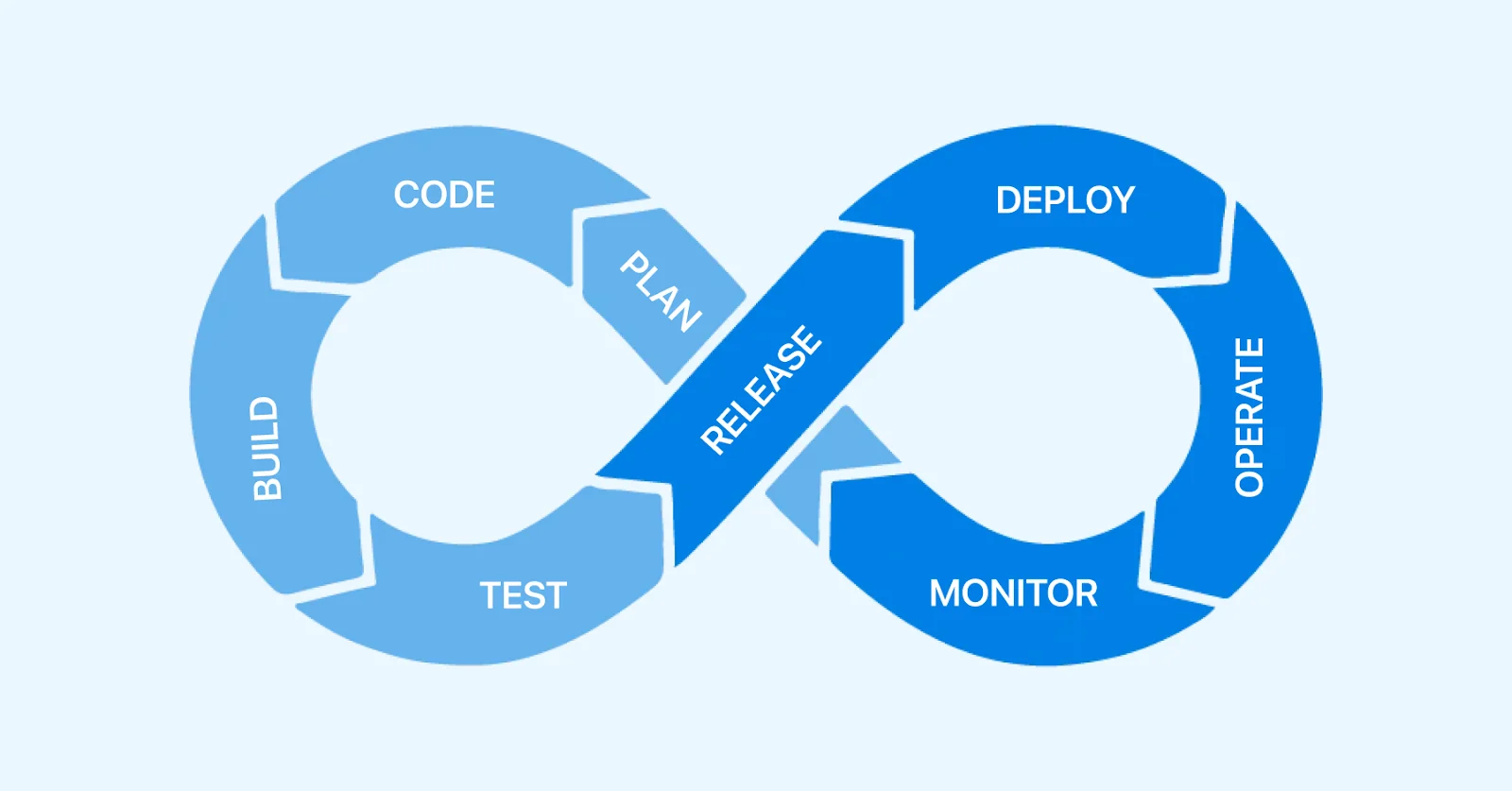
Note: Implement DevOps practices and streamline your software development process. Try LambdaTest Now!
The section below lets us understand why we need a DevOps lifecycle.
Need for DevOps LifeCycle
The need for a DevOps lifecycle arises from the underlying limitations of the traditional software development process. This process has separate development and operation teams, resulting in a gap in the knowledge between teams and a disconnected workflow.
Such issues mainly result in miscommunication and inter-team misconceptions, ultimately contributing to frequent delays in software releases. Considering the waterfall model, each software application development phase is completed before it moves to the next, making it difficult for the team to adapt to the new change requirement.
The DevOps lifecycle effectively addresses the above-mentioned issues, integrating the two traditionally siloed areas (development and operation teams). DevOps uses automation testing tools to enable continuous integration and continuous delivery (CI/CD), allowing frequent and reliable releases. For instance, an organization utilizing DevOps practices could deploy new features multiple times daily, ensuring a quicker response to user feedback and market demands.
Further, the DevOps lifecycle integrates automation testing in the entire development pipeline to help identify and fix bugs or issues. It also involves continuous monitoring and user feedback, which help gain real-time insights into software applications' performance and functionality and improve user satisfaction.
Hence, the DevOps lifecycle is needed because it aligns development and operations teams, improves processes, and ultimately enhances the organization's overall competitiveness and agility in the fast-paced world of technology.
In the following section, we will learn more about the significance of the DevOps lifecycle.
Significance of DevOps LifeCycle
Implementing the DevOps lifecycle brings various advantages, leading to expedited and more dependable software delivery, enhanced quality, and heightened efficiency. Here are the key benefits of the DevOps lifecycle.
- It is a unique approach that includes iterative and infinite approaches, addressing challenges by creating a more knowledgeable environment for software teams.
- It ensures that tasks in software development are more evenly distributed and well-organized, minimizing the communication/knowledge gap when both teams share responsibilities.
- It necessitates a significant cultural shift that eliminates communication barriers, promoting effective collaboration and resource-sharing among individuals.
- It enables software applications to be developed promptly through collaborative efforts, carefully considering their requirements and preferences.
- It is crucial in mitigating the impact of bottlenecks, rollbacks, and deployment failures on efficiency.
- It promotes stability through thorough testing, automation, and continuous feedback, resulting in more steadfast and dependable production environments.
- It strongly emphasizes monitoring and analytics, improving organizations' visibility into system performance, user behavior, and other QA metrics.
- It also promotes adaptability to changing software requirements and market conditions.
Components of the DevOps LifeCycle
As discussed earlier, the DevOps lifecycle streamlines development processes from initiation to completion, involving the organization in ongoing development activities, ultimately leading to accelerated delivery times. This method primarily includes seven key components.
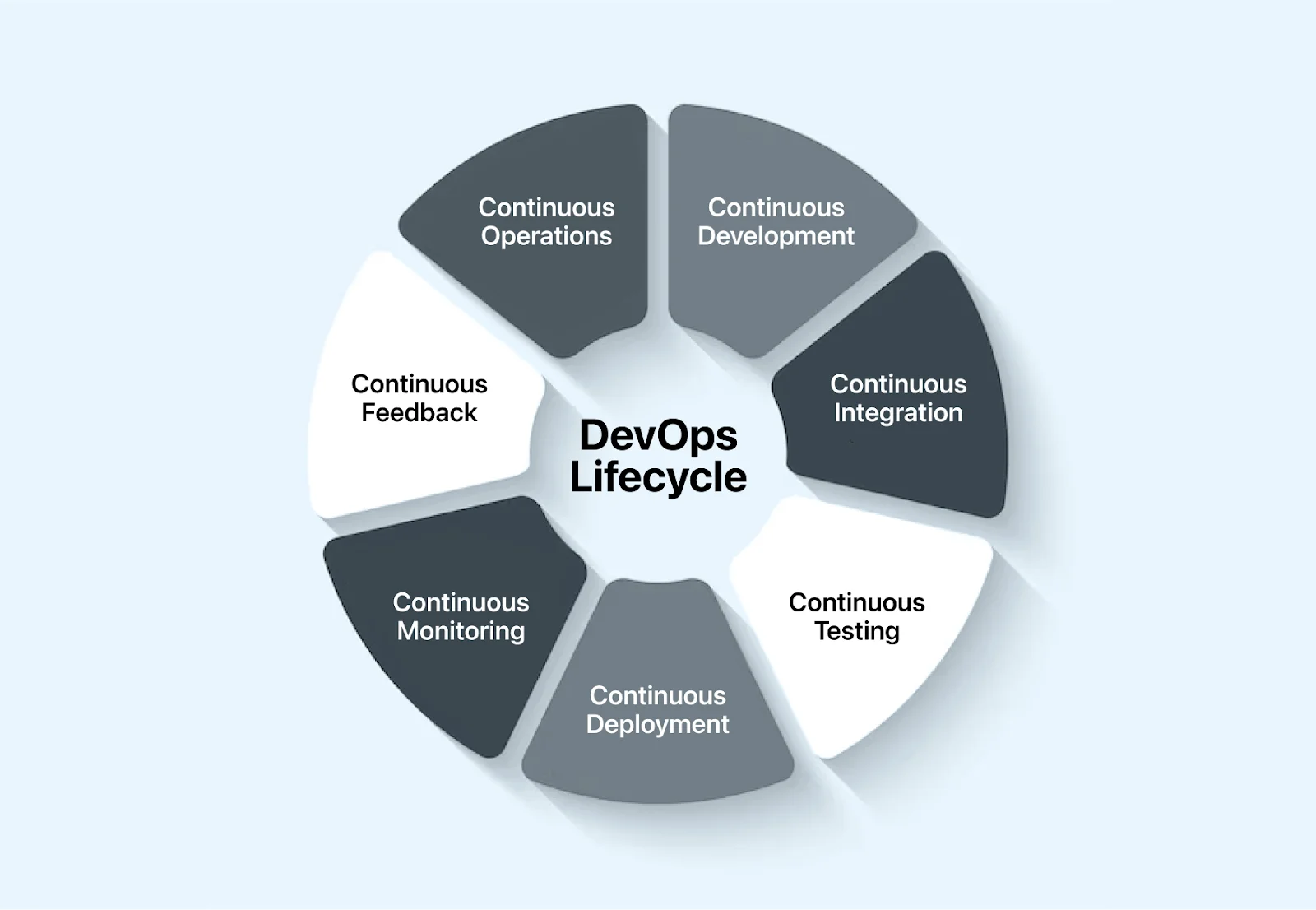
Continuous Development
In this phase, continuous development involves collaboration among developers, testers, and other stakeholders, primarily focusing on project planning and coding. During this phase, stakeholders and project needs are gathered and discussed, leading to the initiation of coding by the development team once a consensus is reached on the business requirements.
The development phase comprises all aspects of coding, including authoring by team members, testing, code integration, and transforming code into deployable artifacts across different environments. At the same time, the code can be written in any language, and version control tools are utilized for effective maintenance.
In contrast to implementing changes in one large batch, developers opt for small, incremental changes to the software application, addressing elements like bug fixes, new features, code improvements, and code refactoring. This incremental approach facilitates continuous software development.
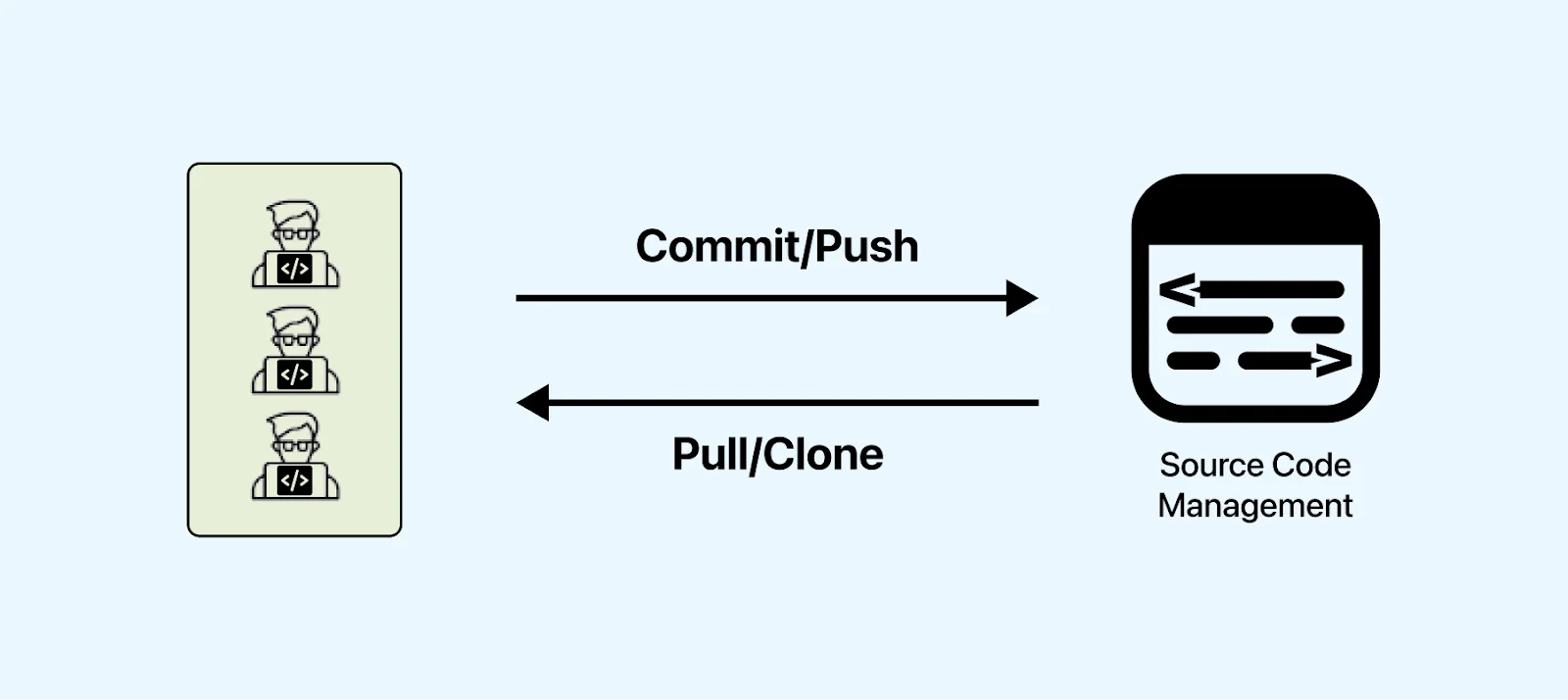
DevOps teams strive for rapid innovation while maintaining quality, stability, and productivity. They achieve this by using highly productive tools, automating repetitive tasks, and iterating in smaller increments through automated testing and continuous integration.
DevOps does not require specific tools in the planning phase. However, the development team relies on various version control tools, such as GitLab, Git, TFS, SVN (Subversion), Mercurial, Jira, BitBucket, Confluence, and Subversion, for effective code maintenance.
Key aspects of continuous development include:
- Code Integration: It helps developers integrate their code changes into a shared repository to keep the codebase updated.
- Code Review: It regularly reviews code to maintain code quality and adherence to coding standards.
- Feedback Loop: Monitoring the software application helps identify areas for improvement and informs developers of necessary changes.
- Collaboration: It allows developers, testers, and operations teams to collaborate effectively, essential for smooth and efficient development processes.
- Agile Practices: It implements Agile practices such as iterative development and frequent releases, which are integral to continuous growth and enable teams to respond quickly to changing requirements.
Many companies prefer Agile methodologies for collaboration and use Scrum, Lean, and Kanban. Git and Jira are widely recognized as the most popular tools, especially for complex projects. They promote outstanding collaboration between teams during development.
Continuous Integration (CI)
In this phase, continuous integration involves a series of steps related to testing processes and incorporating client feedback to introduce new features. Once the code is written, it is committed to a shared repository, where a series of events for seamlessly integrating the code is initiated daily or weekly. Each commit is then built, allowing for early issue detection. The code-building process comprises compilation and includes code review, unit testing, integration testing, and packaging.
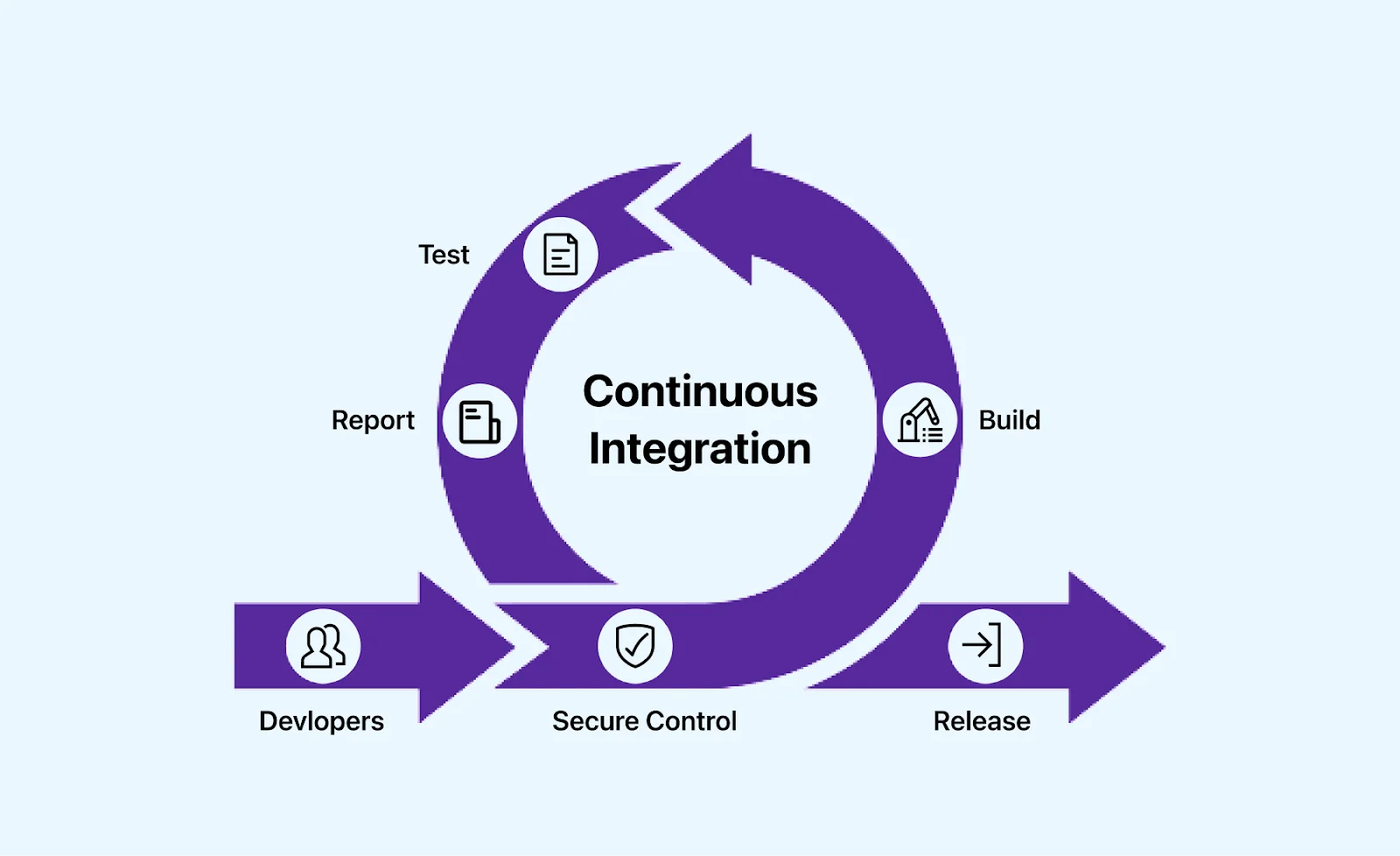
Throughout this stage, errors in the program are identified and addressed at every testing phase, with corresponding updates made to the source code. This stage transforms integration into a continuous process where code is tested before each commit, and necessary tests are strategically planned. It ensures the continuous integration of new code functionalities with the existing source code, ensuring a smooth fit within the entire software application.
Key aspects of continuous integration include:
- Code Integration:Frequent Code Commits: It allows developers to frequently commit the code to the shared repository.
- Automated Builds: It then initiates the build process automatically to complete the code and generate executable files.
- Immediate Feedback: It receives feedback based on its code commits, enabling developers to address the issues quickly.
- Integration of Changes: It helps identify errors in the early development process by regularly integrating changes from multiple developers into the main branch.
- Build Artifacts: It generates build artifacts, such as executable files, for further testing or deployment.
- Consistency: It ensures that the code vase is always working.
In the continuous integration process, the team uses widely used platforms like Jenkins to automate the build and testing of the codebase. This tool is crucial in fetching and building the updated code, facilitating seamless integration within software applications. However, it's important to note that tools like CircleCI and Buddy are adapted for business use. Therefore, ensuring compatibility with your organization's and software project's specific needs is essential when selecting continuous integration solutions.
To learn how to implement Jenkins for continuous integration, watch the video tutorial on Jenkins, get valuable insights, and make your development and testing process efficient.
Continuous Testing
This phase occurs after progressing through the development and integration stages, and the DevOps lifecycle transitions to testing, where the code undergoes careful testing for early identification of potential bugs or errors. Continuous testing involves automating testing procedures to validate software application changes at each pipeline stage and providing feedback to the development team without human intervention.
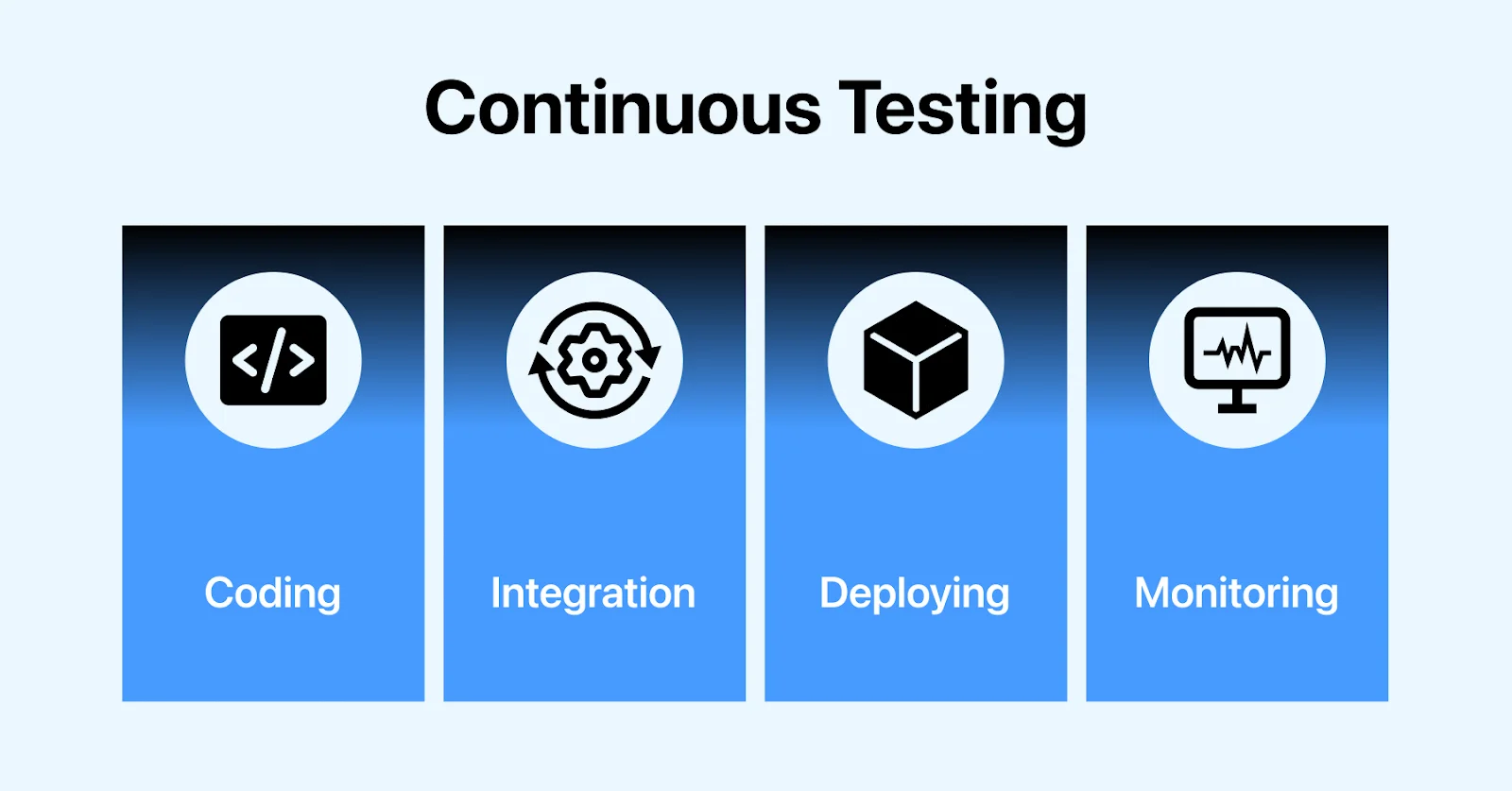
The Quality Assurance (QA) process is crucial in evaluating whether the software applications align with client requirements, guaranteeing a defect-free program. Additionally, in continuous testing, docker containers are used to replicate the complete test environment.
Key aspects of continuous testing include:
- Automation: It relies on automated tools and frameworks to execute tests efficiently.
- Early Testing: It conducts unit and integration tests as early as possible in the development process to catch bugs and issues.
- Comprehensive Test Coverage: It provides complete test coverage, including functional, non-functional, and performance testing.
- Risk-Based Testing: It helps identify and prioritize the high-risk areas for testing, ensuring that testing efforts are optimized.
Automation tools such as Selenium, Cypress, and Playwright are commonly used to automate test case execution, leading to faster and more efficient testing processes. This automated approach saves time, effort, and labor compared to manual testing, improving overall efficiency.
One common challenge in automation testing is the need to maintain a set of test environments and configurations, which includes various browsers and browser versions, as well as managing operating systems and device types or models. To resolve these challenges, organizations can leverage cloud-based platforms that can help scale and maintain better infrastructure. One such platform is LambdaTest.
LambdaTest is an AI-Native test orchestration and execution platform that lets you run manual and automated tests at scale with over 3000+ real devices, browsers, and OS combinations.
This continuous testing platform is equipped with all the necessary security compliance measures for any organization. It helps coordinate and manage tests over the cloud, making it easier to scale the testing process within an organization.
Furthermore, LambdaTest enables web application testing and offers a wide range of mobile device labs for mobile app testing. It includes real device cloud, emulators, and simulators, providing a comprehensive solution for testing mobile applications.
Subscribe to the LambdaTest YouTube channel for more videos on Selenium testing, Playwright testing, Cypress testing, and more.
This platform simplifies the creation, management, execution, and analysis of tests for web, API, desktop, and mobile applications across various environments. It centralizes these processes with minimal requirements in engineering and programming skills.
Using this platform, you can access detailed test reports that indicate the status of your test cases—whether they passed or failed. You can perform debugging on the failed test cases to identify an issue using different test logs.
To get deeper insights on your passed/failed test suites, you can leverage test analytics for deeper test insights that consist of the test summary, browser categorization, test trends, test status ratio, and more.
Test analytics is an AI-Native test observability platform that accesses vital information on tests, including test inconsistencies, the number of tests, and tests categorized by their status and environments.
Moreover, LambdaTest also comes with an AI-infused Test Intelligence that helps identify the issues using root cause analysis for quick resolution and efficient problem-solving.
Continuous Deployment/Continuous Delivery (CD)
Despite distinct differences, continuous deployment and continuous delivery are two closely related practices in DevOps.
In this phase, continuous delivery is a crucial aspect of the deployment phase in the DevOps lifecycle. It involves configuring servers to ensure a seamless code rollout, where development teams send code to servers throughout the production stage and schedule server upgrades while keeping configurations consistent.
Configuration management tools such as Puppet, Chef, SaltStack, and Ansible are vital in executing tasks easily and regularly during continuous delivery. These tools help maintain uniformity across development, test, staging, and production environments, enabling rapid scaling-up and scaling-down of instances.
Continuous delivery eliminates the need for planned releases, accelerating the feedback system. It allows developers to address concerns promptly and with increased accuracy, ultimately improving the overall efficiency of the deployment process.
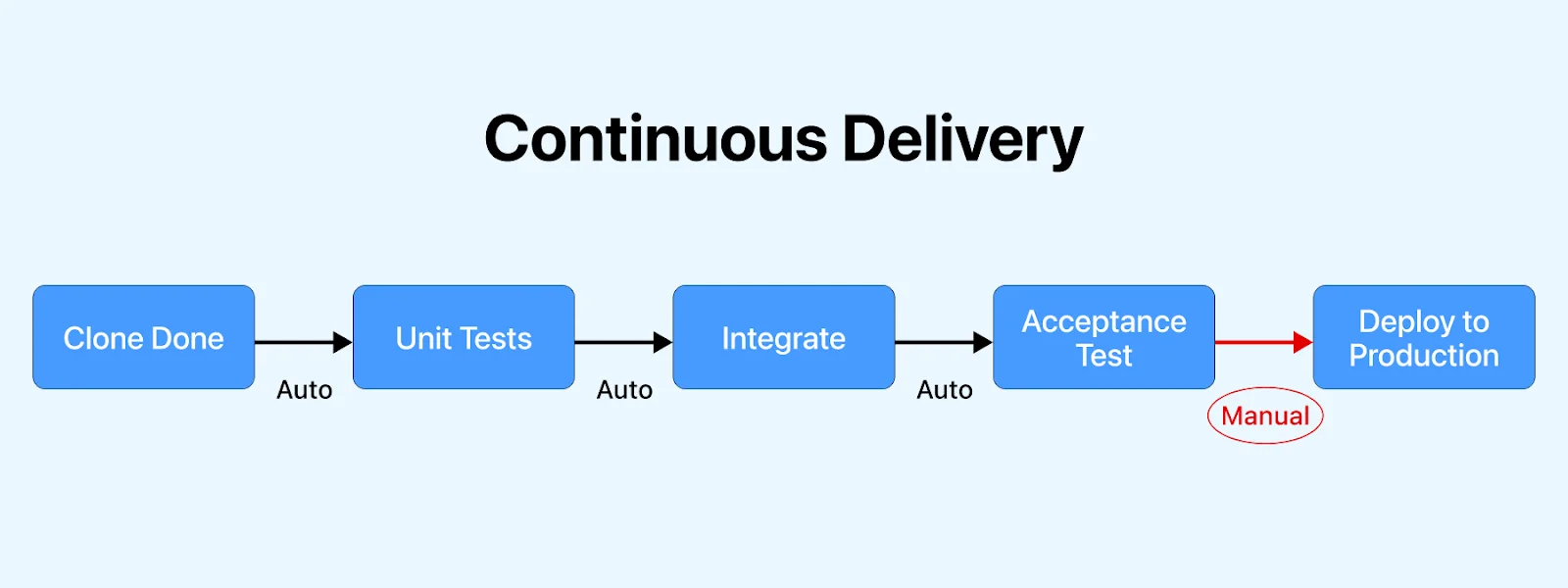
In this phase, continuous deployment is a software engineering practice that takes a further step from continuous delivery. It ensures that code changes are continuously released into the production environment, aiming to release a new version whenever developers make changes and automatically get them to the end-users.
In continuous deployment, codes are run and maintained in a simulated environment to ensure the ultimate quality is considered. Continuous deployment allows development teams to make frequent code updates, enabling them to promptly test, improve, and release new features to users in a streamlined and timely manner.
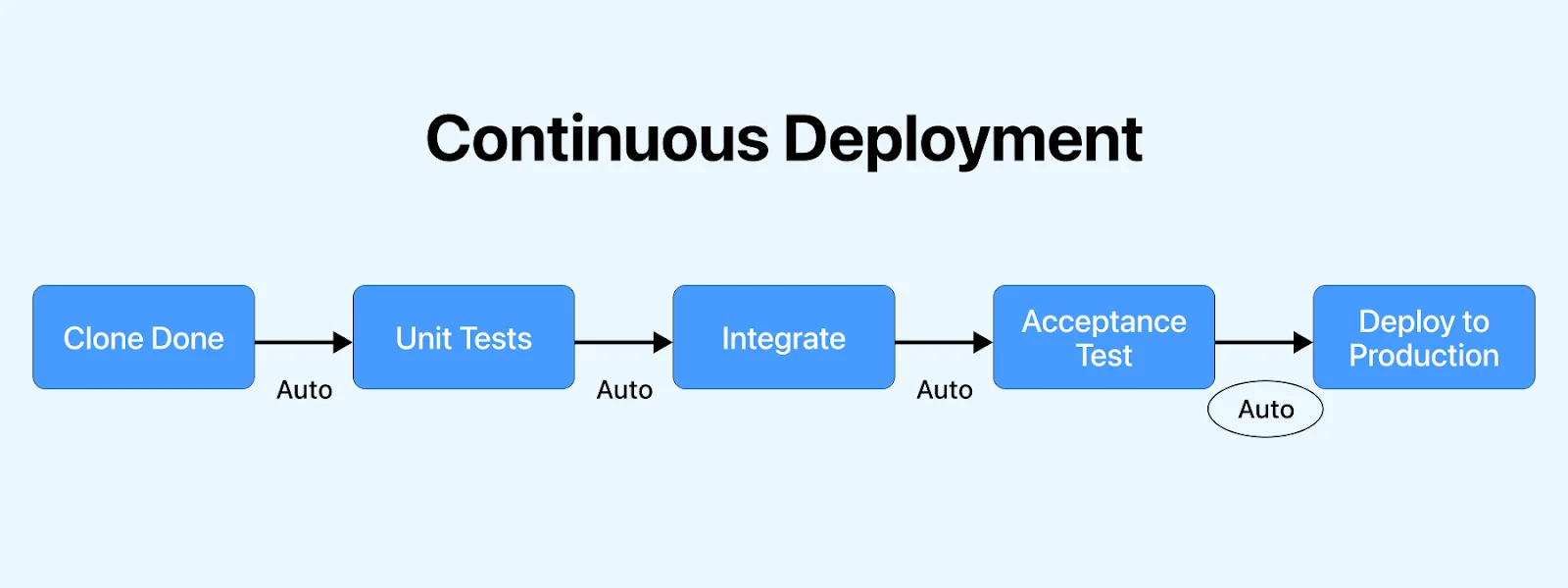
To enhance the deployment process, performing CI/CD testing is crucial. It ensures that code changes are continuously integrated, tested, and deployed. CI/CD testing helps reduce the risk of introducing defects into the production environment by catching bugs and issues early in the development cycle. It ultimately increases software quality, reduces time to market, and enhances the overall development process.
Key aspects of continuous deployment/delivery include:
- Incremental Updates: It focuses on minor, incremental updates that can be deployed quickly and easily.
- Continuous Integration: Its code changes are frequently integrated into the main breach and tested automatically.
- Rollback Mechanism: It helps quickly revert to the previous version in case any issues or bugs cause the application to fail.
- Environment Management: It helps manage different environments (e.g., development, staging, production), ensuring the code changes are deployed to the correct environment.
- Security and Compliance: It ensures the code changes meet security and regulatory requirements during deployment.
Follow this guide to explore the best CI/CD tools and learn more about various continuous deployment and delivery tools that can streamline the development and testing process. Select the tools that best suit your project needs.
Continuous Monitoring
In this phase, continuous monitoring of your application's performance is crucial. Consistent monitoring is implemented throughout this phase to track the application's performance and functionalities, detecting potential system faults such as low memory or unreachable servers.
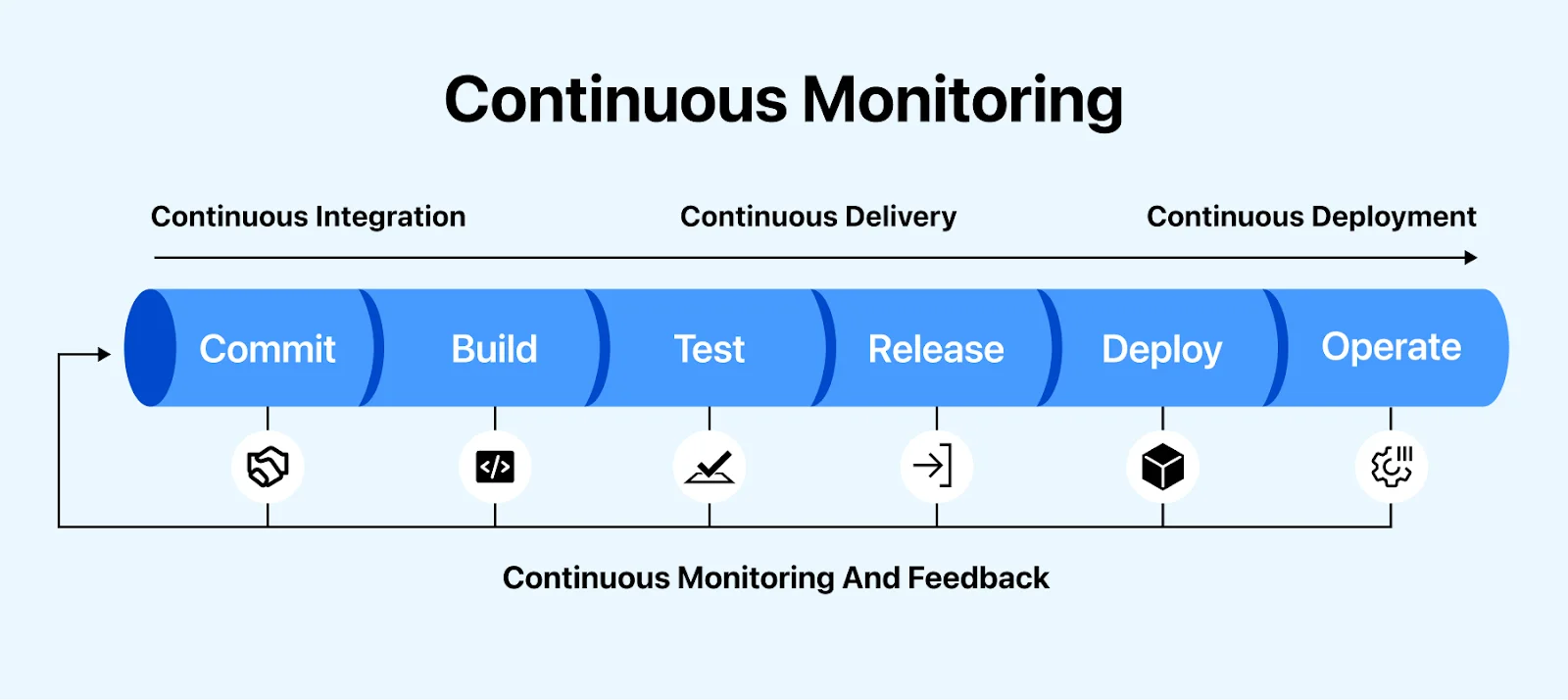
The software's usage is documented and processed to ensure proper functionality. Here, monitoring is understood as obtaining real-time visibility into the system's performance and behavior, offering continuous insights into various metrics. Continuous monitoring takes it further, emphasizing three key factors:
- Real-time data collection and analysis
- Proactive and constant response to risks
- Ongoing data analysis.
This phase identifies the root cause of any issues, ensuring the security and availability of services. Network issues are addressed and automatically rectified upon detection. Popular tools include Splunk, ELK Stack, Nagios, NewRelic, and Sensu. These tools closely monitor the application's performance and servers, enabling proactive software application health checks.
Key aspects of continuous monitoring include:
- Real-time Performance Monitoring: It helps monitor the performance of applications and infrastructure to detect and address issues promptly
- Application Logs and Metrics: It collects and analyzes logs and metrics to gain insights into application behavior and performance.
- Resource Utilization: It involves monitoring the utilization of resources such as CPU, memory, and disk space to ensure efficient usage and prevent bottlenecks.
- Alerts and Notifications: It helps set up alerts and notifications to alert stakeholders about critical issues or performance degradation.
- Security Monitoring: It involves monitoring security threats and vulnerabilities to protect applications and data from cyberattacks.
- User Experience Monitoring: It monitors user interactions with the application to ensure a seamless user experience.
This process enhances productivity, increases software application reliability, and reduces IT support costs. Any significant issues discovered are promptly reported to the development team for resolution in the continuous development phase, leading to faster problem resolution.
Continuous Feedback
In this phase, continuous user feedback collection remains crucial for gaining insights into optimizing the codebase. Implementing automated mechanisms, such as user feedback surveys, automated error reporting, and monitoring systems for performance and usage metrics, facilitates this ongoing process.
The feedback process is comparable to accessing the perspectives of individuals using the software application. Throughout this stage, consistent evaluation of the user’s behavior and input is performed to extract valuable insights. This data is crucial as it sheds light on the app's performance and potential issues while incorporating ideas and suggestions from its user base.
Key aspects of continuous feedback include:
- Timely Feedback: It provides detailed insights into the performance of the software application and development process.
- Data-Driven Decision Making: It depends on data to make informed decisions about the software application.
- Collaboration: It helps build collaboration between developers, testers, operations teams, and stakeholders for better insights into software applications.
Establishing this feedback loop is diversified across multiple channels, including surveys, questionnaires, user interviews, and engagement on social media platforms. This phase is essential in enabling continuous delivery and ensuring the release of an improved program version.
Continuous Operations
In this phase, continuous operations are crucial to minimizing scheduled maintenance and other planned downtime. The focus is on automating release processes, enhancing software quality, and reducing downtime. Organizations can shorten development cycles through continuous operations, consistently promote their software applications, and achieve a faster time-to-market. DevOps practices are crucial in improving software applications, making them more efficient and appealing to new users.
Key aspects of continuous operations include:
- Indirect Response and Management: It helps detect and respond to incidents and outages in the production environment. The operations team diligently works to identify the root cause and implements corrective actions to restore normal operations when issues arise.
- Change Management: Its thorough planning, testing, and gradual implementation of software or infrastructure updates or changes to minimize disruption and risk.
- Monitoring and Alerting: Its real-time data and metrics collected by monitoring tools provide insights into the system's behavior. Alerting mechanisms notify the operations team when predefined thresholds or conditions are breached.
- Backup and Recovery: Its regular backups are taken to safeguard data, accompanied by disaster recovery plans to minimize downtime during significant failures.
Traditionally, developers often had to take servers offline for updates, leading to increased downtime and potentially significant financial costs for the organization. Continuous operation addresses this challenge by automating the software application's startup and subsequent upgrades, eliminating downtime through container management platforms like Kubernetes and Docker.
You would have gained a clear concept of the DevOps components. Let's learn more about the various phases present in the DevOps lifecycle.
Different Phases of the DevOps Lifecycle
There are different phases of the DevOps lifecycle, from planning to deployment; each phase plays a crucial role in ensuring efficient collaboration between development and operations teams, leading to faster delivery of high-quality software. Let's explore each phase of the DevOps lifecycle in detail below.
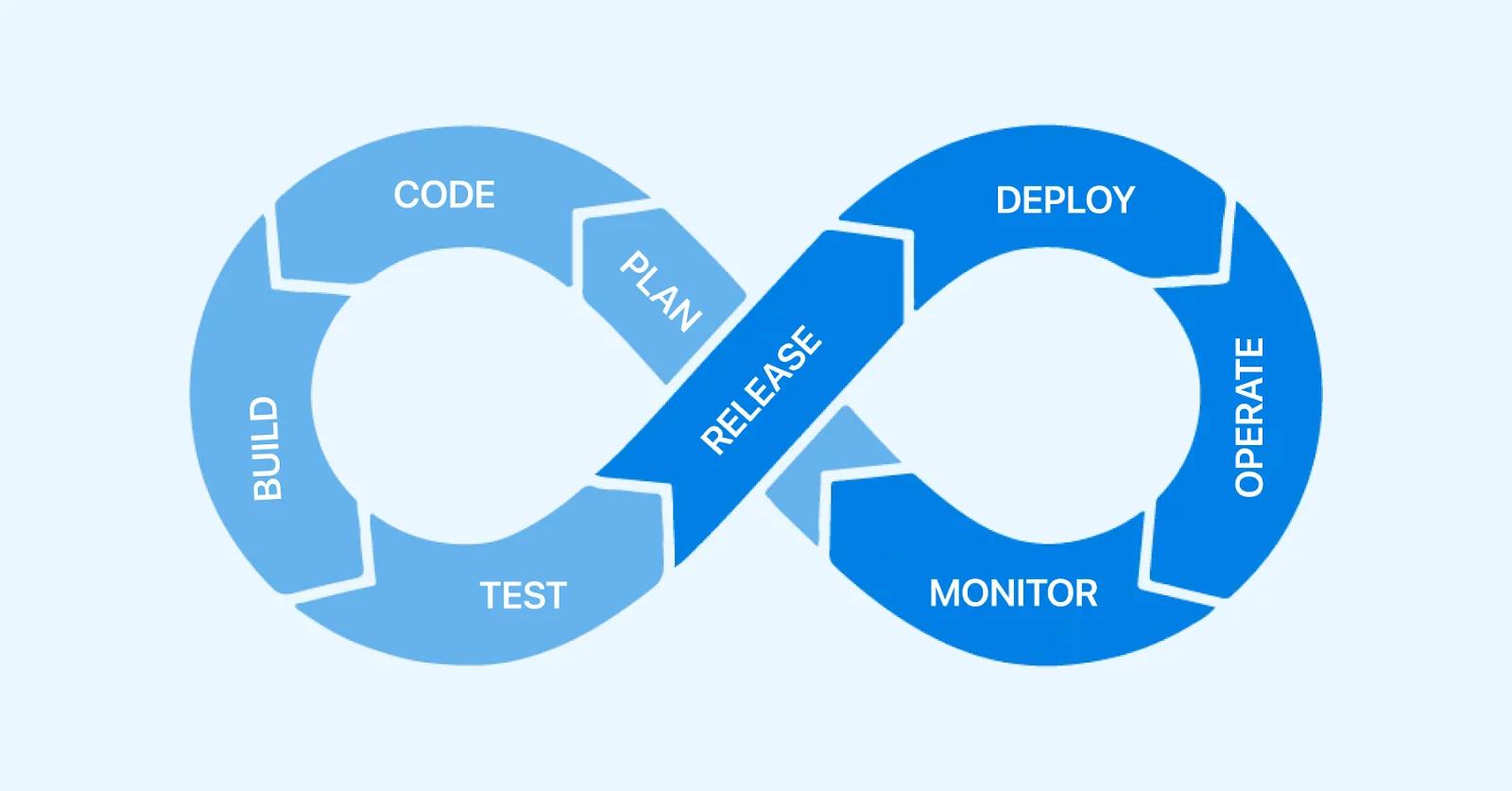
Plan
It is the first phase of the DevOps lifecycle, focusing on developing a comprehensive plan for the software project. It involves defining project goals and strategies to create a roadmap for the effective development of software applications. Collaboration with business stakeholders and teams is vital, as it allows for discussions on the project's requirements and identifies the features that must be delivered in the software applications. This phase provides a clear understanding of the needs and expectations of the stakeholders.
Compared to traditional approaches with linear transitions between phases, the DevOps lifecycle allows for the repetition of each stage as needed. This approach means that the planning phase is strategically designed to anticipate future iterations and potential previous versions. Insights from past iterations are expected to enhance the upcoming iteration, creating a continuous feedback loop. Comprehensive coverage and prevention of overlooking or neglecting any aspect of planning typically require the involvement of all teams.
The following are the activities of the planning phase:
- Decisions are made regarding resource allocation, project timeline, team structures, technology stack, tools, and approaches to mitigate risks.
- Establish SMART (specific, measurable, achievable, relevant, and time-bound) objectives.
- Develop a roadmap outlining the release cycle, milestones, and timeline.
Code
It is the second phase of the DevOps lifecycle, followed by the preceding design stage, where software engineers analyze and identify optimal software development solutions. During this phase, engineers may choose a suitable architectural pattern that aligns with the project's needs and then break down the system architecture into more manageable components.
At this stage, developers start with the coding work. Development teams leverage tools and plugins like Git to streamline the process, ensuring they steer clear of security issues and suboptimal coding practices. They then write the code, following the specifications outlined during the planning phase and considering how the code will operate within the project's overall framework.
The following are the activities of the code phase:
- Developers in the team work collaboratively to write and review code.
- The team uses a version control system like Git to track and manage code changes.
- The team uses static code analysis tools to ensure the code aligns with coding standards and best practices.
Build
It is the third phase of the DevOps lifecycle; once developers complete the coding stage, they upload the code to the shared code repository using build tools like Maven and Gradle. It implies that the code becomes an integral part of the project, and if necessary, adjustments are made to accommodate this new code.
The developer then submits a code addition request, subject to review as needed. Approval is granted if the code is deemed ready for uploading, and subsequently, it gets incorporated into the project. This approach remains effective even when introducing new features and addressing bugs.
Next, the developer submits code, which undergoes a reviewing process. If the code works as expected and is ready for uploading approval is granted, and it is then incorporated into the project present in the production environment. This approach remains effective for introducing new features and fixing bugs.
Incorporating code is frequently facilitated through platforms like GitHub or similar version control platforms, offering flexible methods for managing code changes. Here, continuous integration (CI) plays a pivotal role, ensuring the early detection and resolution of any integration issues and maintaining the codebase in a consistent and operational state.
After the lead developer approves the submitted code, the continuous integration process is triggered, starting the build procedure. The continuous integration server compiles the source code into machine code that is capable of execution. It also identifies dependencies, such as external libraries and frameworks, necessary for proper code execution. This process results in a "build artifact," a deployable and executable form of the code, ready for testing and distribution to end users.
The following are the activities of the build phase:
- The team automates the build process using tools like Jenkins, Travis CI, etc.
- Integrate the source code into the binaries or the executable artifacts.
- Unit tests are performed to verify the appropriateness of individual code components.
Selecting the right tools is crucial to streamline development during the build process. Jenkins and Travis CI are popular choices, but understanding their differences is critical to choosing the best fit for your project. Learn more about Jenkins vs Travis CI in this guide to determine which CI/CD tool aligns with your process needs.
Test
It is the fourth phase in the DevOps lifecycle. Once the build reaches completion, it undergoes deployment to the test environment for a comprehensive array of tests, including user acceptance tests, security tests, integration tests, performance testing, etc. The teams use automation testing frameworks like Selenium, Cypress, and more to ensure the software meets high-quality standards. Essential tests are conducted to verify the project's adherence to the plan, with a thorough review of potential edge and corner case issues.
The test strategy document should carefully outline the test strategy, while specific test scenarios and operational details are documented in the test plan. (An "edge case" pertains to an issue that arises solely under extreme operating conditions, whereas a "corner case" occurs when multiple conditions align in a specific manner).
Automation testing is essential in DevOps because it offers faster and more reliable code change verification. Hence, this reduces manual effort and facilitates continuous integration (CI) and continuous delivery (CD). Testers must perform automated testing at various levels, including unit, integration, and system testing.
- Unit testing is performed to validate the functionality of individual code units.
- Integration testing ensures smooth data flow between code units or components, verifying effective communication.
- System testing assesses user interaction in an environment resembling the production environment.
To automate these tests, Quality Assurance (QA) teams typically choose between creating their automated test scripts using automation testing frameworks like Selenium, Cypress, Playwright, and more, demanding a certain level of technical expertise, or investing in an automation testing tool with low-code test script creation capabilities. The decision to opt for "build" or "buy" depends on the capabilities of each team.
Automation can be carried out in both local and remote settings. Nevertheless, cloud-based testing is frequently recommended with organizations' increasing adoption of digital transformation. Cloud testing brings numerous advantages and is a valuable option for scalable and reliable testing practices. This approach enables testers to transition their testing to a cloud grid, eliminating the need to manage an in-house grid and reducing operational overheads.
One such cloud-based testing platform is LambdaTest. LambdaTest is an AI-Native test orchestration and execution platform that lets you run manual and automated tests at scale with over 3000+ real devices, browsers, and OS combinations. This platform also allows you to perform parallel testing using the online Selenium Grid, which can help accelerate software release cycles.
Following test execution, detailed reports on the test results are essential. These reports offer deep insights into passed and failed tests and any discovered defects. These results should guide QA teams in promptly addressing identified issues.
Release
It is the fifth phase of the DevOps lifecycle. It occurs once the code is verified and ready for deployment, having undergone a final assessment for production readiness. This stage involves organizing plans, scheduling, and supervising the build process in a distinct environment.
Automated methods can be used for deployment to an environment. However, manual deployment is preferred when transitioning to the production environment. Several release management procedures are typically employed for manual deployment in the production environment to minimize customer impact.
If all specified requirements are met, and the project is successfully tested for any bugs or issues, it advances to the deployment phase led by the DevOps team.
The following are the activities involved in the release phase:
- The team plans and coordinates the release schedule of the software applications.
- They also implement versioning for the software applications to track and manage the diverse releases.
- It effectively manages and communicates the changes to the stakeholders.
- The team creates documentation outlining new features, bug fixation, and other information.
Deploy
It is the sixth phase of the DevOps lifecycle. Infrastructure-as-Code helps construct the production environment and initiate the build through various tools. Carefully tested code is released and deployed across multiple environments, including staging, UAT, and production. The software application is now accessible for users to engage with, although the level of access varies in each environment.
- The staging environment, also known as the pre-production environment, closely replicates the production environment for software testing. It previews the software's functionality as a link between the development and production environments, ensuring alignment with stakeholders' expectations.
- The UAT environment is where the code is deployed post-software testing in the staging environment. It mirrors the production environment, but testing is conducted by customers or product owners instead of the QA team.
- The production environment is the final deployment location, often called the "live" environment, where all customers can interact with the software in real-time. During this stage, encountering bugs is not anticipated, and any identified bugs prompt immediate notification to the QA team.
Automated deployments are crucial for creating a seamless workflow, simplifying the deployment process, and reducing human errors. Continuous deployment (CD) enables teams to automate the consistent release of features into production. The strategic use of feature flags allows for the gradual and systematic delivery of new code to users, enhancing software development teams' velocity, productivity, and sustainability.
An illustrative example of this phase in action involves a team using a deployment automation tool like Ansible or Chef to deploy the application across diverse environments.
For automated deployment, numerous systems offer scheduler support. Additionally, deploying dashboards enables users to capture accurate insights, providing a view of optimization scenarios and analytics on trends.
Operate
It is the seventh phase of the DevOps lifecycle. After the software undergoes deployment, it enters the operational phase, where the application becomes fully accessible to end users. The software application is monitored and managed within the production environment during this stage. Operations teams manage the software application's performance, availability, and security, promptly addressing incidents or issues. Real production environment tests are conducted, marking the initiation of end users utilizing the software application.
The operations team assumes responsibility for the software application's management in the production environment, undertaking various tasks to ensure its smooth operation and availability and implementing optimization decisions to enhance user experience. Utilizing monitoring tools, they gather and analyze real-time data from all software stack components, including servers, databases, networks, or application metrics, maintaining constant awareness of its health.
This phase is crucial but needs to be more conclusive; it serves as a guide for future development cycles and comprises the configuration of the production environment and the implementation of any necessary runtime requirements.
An illustrative example of this phase in practice involves a team leveraging monitoring tools like Nagios, Prometheus, and the ELK stack (Elasticsearch, Logstash, Kibana) to facilitate the monitoring and logging of application metrics and logs.
The following are the key activities of the operational phase:
- Software applications are continuously optimized for better performance and resource utilization in this phase.
- Logs and performance metrics are monitored to find issues proactively.
- It ensures that the software application can scale horizontally or vertically based on demand.
Monitor
It is the eighth phase of the DevOps lifecycle; this phase involves observing product usage, collecting feedback, identifying issues, and finding areas for enhancement. The application is monitored and maintained in the production environment during this stage. Tasks include monitoring performance, tracking user behavior, and resolving issues. The gathered information is then used to improve the development process in subsequent iterations. This phase is crucial for planning future actions and refining the development pipeline.
Using practical monitoring tools to track an application's progress is vital, providing alerts and detailed performance reports and aiding issue capture with a user-friendly interface. DevOps monitoring tools such as Grafana, Datadog, and the ELK stack (Elasticsearch, Logstash, Kibana) offer visualizations, alerts, and dashboards for proactive monitoring and troubleshooting.
In this phase of the DevOps lifecycle, the Ops team establishes a feedback loop by transmitting the operational data gathered to the Dev team. It helps recognize improvement areas, monitor key performance indicators (KPIs), and evaluate the necessity for software modifications. The DevOps lifecycle starts anew, with each iteration culminating in an improved software version.
Now that we have explored the different phases of the DevOps lifecycle and its components in detail let's delve into understanding the best practices.
Best Practice of DevOps LifeCycle
Organizations can follow several best practices to streamline their software development and delivery processes. The following are some of the best practices of the DevOps lifecycle that you should know about.
- Providing an initial solution for the customer proves valuable, saving time, effort, money, and resources that become crucial later on. Additionally, it reinforces the "shift left" concept at the heart of the DevOps process, allowing teams to measure variables essential promptly.
- Cultivate a culture of collaboration and effective communication among development, operations, and other teams involved in the software delivery process. Advocate for regular meetings, cross-functional collaboration, and the use of collaboration tools to ensure alignment and shared goals.
- When developers encounter challenges adapting to new requirements, the organization must intervene, understand their struggles, and offer support. Proper education and training in DevOps and related tools are crucial. Sit with the team, align everyone regarding the transition, and address any doubts or queries.
- Establish resilient CI/CD pipelines, automating the build, testing, and deployment processes. Continuously integrate code changes, execute automated testing, and strive for frequent, more minor releases to minimize risk and ensure faster feedback loops.
- For a seamless DevOps transformation, organizations must set specific objectives and define performance metrics at the outset. They must also define appropriate benchmarks before involving developers in the DevOps methodology.
- Automate as many process operations as possible within a DevOps workflow without compromising the quality of the team's work. Numerous activities in the DevOps pipeline phases, such as automated testing, can be automated without regular manual intervention.
- Implement a comprehensive monitoring software application to gain insights into performance, user behavior, and system health. Utilize monitoring tools and analytics to identify issues, specify areas for improvement, and collect feedback from end-users.
- Embrace security monitoring and assurance automation practices within DevOps, noting that applying automated security controls does not hinder DevOps agility.
Conclusion
Currently, the implementation of the DevOps lifecycle is expanding across organizations to optimize the entire software development process. It primarily emphasizes collaboration between developers and operations teams, aiming for speed, cooperation, and meeting users' requirements. The journey from the initial idea to bringing software applications to market involves multiple steps, enabling collaboration across various teams and companies. Integrating all phases within an Agile development sprint and utilizing DevOps toolchains to address crucial stages.
Organizations must recognize that DevOps isn't a quick fix but a strategy for long-term improvements. Instant solutions for all problems shouldn't be expected with DevOps. Therefore, organizations contemplating the adoption of DevOps best practices should proceed cautiously and ensure it aligns with their needs before implementation. Furthermore, the DevOps methodology is used to enhance the efficiency of software applications. To accomplish this, business organizations must adhere to the best practices of the DevOps lifecycle to achieve success and maintain a competitive edge.
On This Page
Frequently asked questions
- General
Did you find this page helpful?
More Related Hubs

Start your journey with LambdaTest
Get 100 minutes of automation test minutes FREE!!



